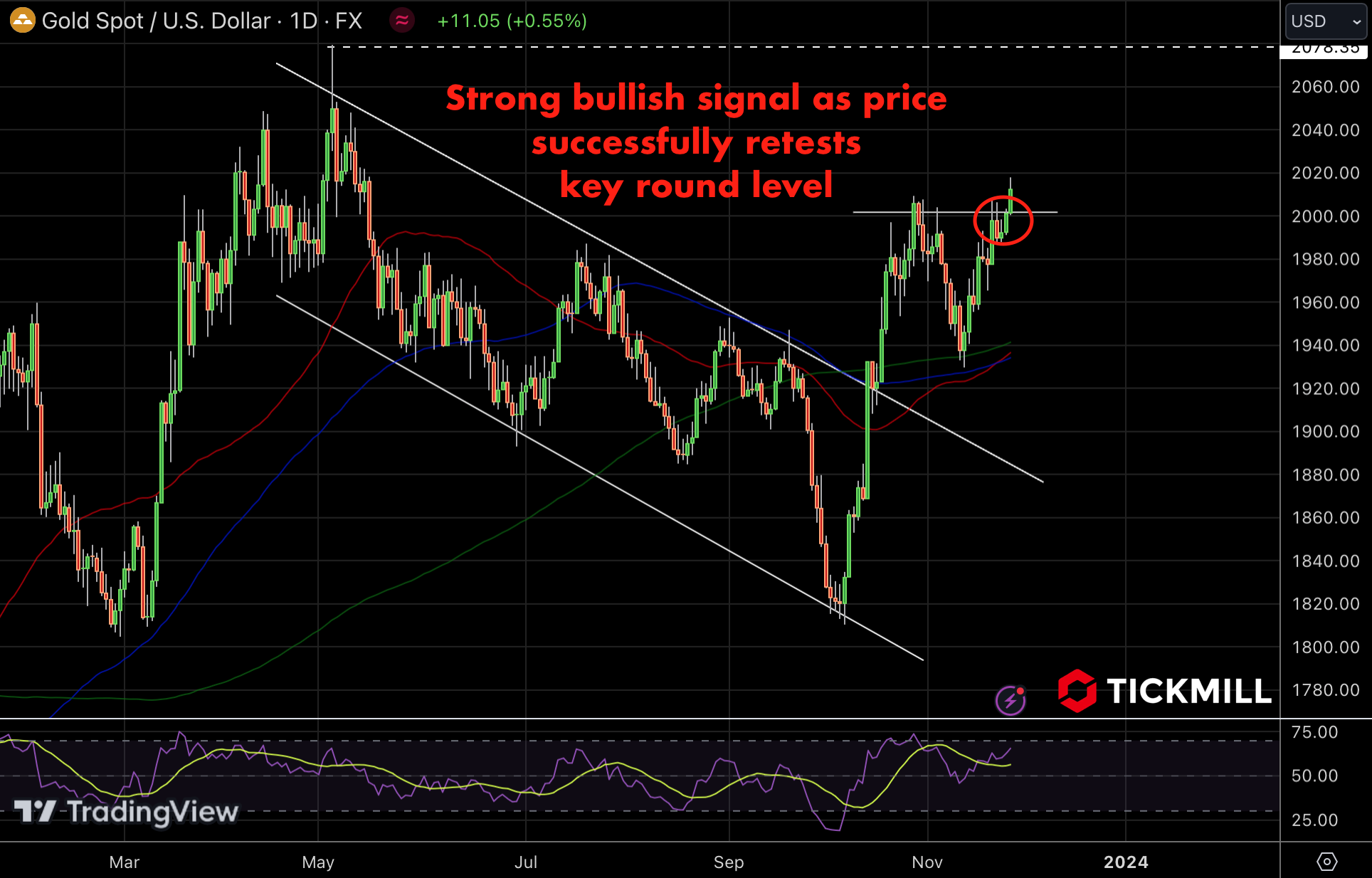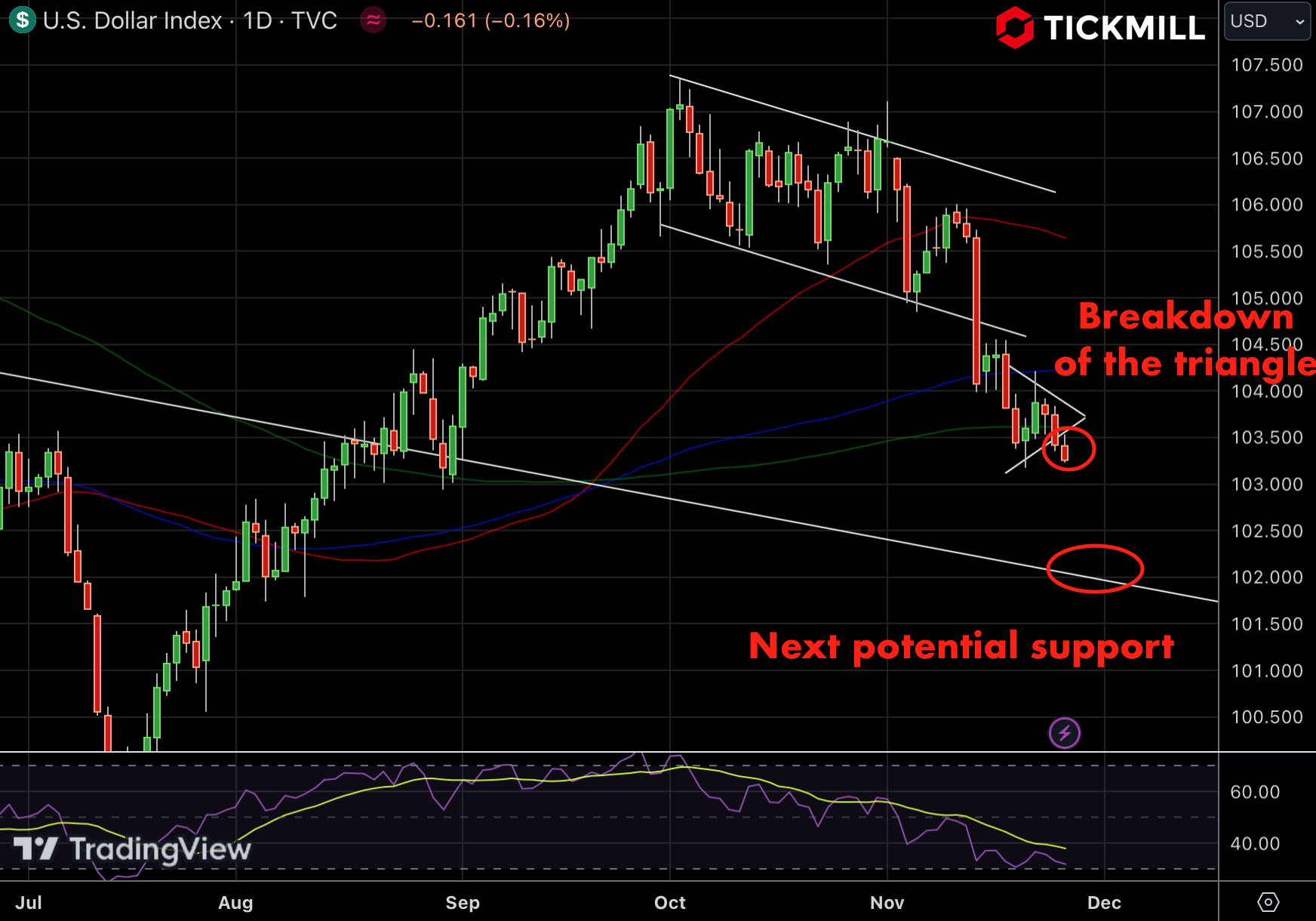tickmill-news
Well-known member
- Messages
- 393
- Likes
- 1
Dollar Under Pressure: Assessing Markets and Trends in Light of Key Developments
Major currency pairs are treading water this Monday as markets gradually get back into the swing of things following the Thanksgiving Holiday last week. The AUDUSD saw a slightly more noticeable upward push, climbing 0.3%, exerting pressure against the 0.66 round level—the highest since August. The bullish sentiment on the pair is underpinned by better-than-expected data from China last week and signs of persistent price pressures in the Australian economy.
European equities kicked off the week on a weak note, with key EU stock indices drifting lower by 0.2-0.3%. US futures are also on a downward trend, although losses are capped at 0.5%. Equity markets seem to be taking cues from the crude oil market, where prices slumped due to concerns that OPEC may not reach an agreement on production quotas during the Thursday meeting, conducted remotely. Key crude oil benchmarks, WTI and Brent, both erased more than 1% on Monday. The decline may be associated with a worrisome demand outlook, adding pressure on risk assets.
Gold prices broke through the key psychological mark of $2K per troy ounce, continuing their upward march with a 0.6% gain. As mentioned last week, the breakout resulted from the second retest of the round level since October. The US interest rate outlook is turning more dovish due to the waning economic expansion momentum seen in the latest US data, leading to expectations of a less hawkish stance by the Fed. Gold prices are inversely related to expectations of real interest rate in the US as the demand for it is a function of the level of overall uncertainty about growth outlook and opportunity cost from not investing into risk-free assets (US inflation-indexed bonds, TIPS).

The US Dollar has retreated by 3.5% from its October peak, driven primarily by market perception that the Fed is nearing the end of its tightening cycle. This sets the stage for risk-taking behavior in equities, easing selling pressure in bond markets, allowing investors to put money to work in fixed income. Note that seasonal factor comes with minus sign into dollar equation in November and December which also an important technical bearish signal. As we noted in our previous technical analysis update for USD, Dollar index after breakout of bearish channel consolidated in a triangle which was eventually broken on Monday:

The current short-term outlook for the dollar suggests a heightened vulnerability to further decline, with the next significant support level anticipated near 102 level. This level could hold significance as it aligns with the upper bound of the previous medium-term bearish channel. The idea is that this bound will transition from strong resistance to support level.
It’s crucial for the markets participants to remain vigilant, as a breach of this level could signal a continuation of the downward trend, while its successful validation as support may introduce a shift into current trajectory.
The economic landscape this week appears relatively calm, with a scarcity of events that might attract widespread attention. Scheduled are comments from Fed speakers tomorrow (Waller, Bowman, Barr, Goolsbee), on Wednesday (Mester), on Thursday (Williams), and on Friday (Powell). Thursday will also bring unemployment claims, Beige Book, and Core PCE reports, while Friday sees ISM releasing the PMI report for the US manufacturing sector. Additionally, Thursday will feature flash estimates of Eurozone inflation, with the core figure likely decreasing from 4.2% to 3.9%, potentially lifting the Euro even higher against the dollar.
Disclaimer: The material provided is for information purposes only and should not be considered as investment advice. The views, information, or opinions expressed in the text belong solely to the author, and not to the author’s employer, organization, committee or other group or individual or company.
High Risk Warning: CFDs are complex instruments and come with a high risk of losing money rapidly due to leverage. 75% and 72% of retail investor accounts lose money when trading CFDs with Tickmill UK Ltd and Tickmill Europe Ltd respectively. You should consider whether you understand how CFDs work and whether you can afford to take the high risk of losing your money.
Major currency pairs are treading water this Monday as markets gradually get back into the swing of things following the Thanksgiving Holiday last week. The AUDUSD saw a slightly more noticeable upward push, climbing 0.3%, exerting pressure against the 0.66 round level—the highest since August. The bullish sentiment on the pair is underpinned by better-than-expected data from China last week and signs of persistent price pressures in the Australian economy.
European equities kicked off the week on a weak note, with key EU stock indices drifting lower by 0.2-0.3%. US futures are also on a downward trend, although losses are capped at 0.5%. Equity markets seem to be taking cues from the crude oil market, where prices slumped due to concerns that OPEC may not reach an agreement on production quotas during the Thursday meeting, conducted remotely. Key crude oil benchmarks, WTI and Brent, both erased more than 1% on Monday. The decline may be associated with a worrisome demand outlook, adding pressure on risk assets.
Gold prices broke through the key psychological mark of $2K per troy ounce, continuing their upward march with a 0.6% gain. As mentioned last week, the breakout resulted from the second retest of the round level since October. The US interest rate outlook is turning more dovish due to the waning economic expansion momentum seen in the latest US data, leading to expectations of a less hawkish stance by the Fed. Gold prices are inversely related to expectations of real interest rate in the US as the demand for it is a function of the level of overall uncertainty about growth outlook and opportunity cost from not investing into risk-free assets (US inflation-indexed bonds, TIPS).

The US Dollar has retreated by 3.5% from its October peak, driven primarily by market perception that the Fed is nearing the end of its tightening cycle. This sets the stage for risk-taking behavior in equities, easing selling pressure in bond markets, allowing investors to put money to work in fixed income. Note that seasonal factor comes with minus sign into dollar equation in November and December which also an important technical bearish signal. As we noted in our previous technical analysis update for USD, Dollar index after breakout of bearish channel consolidated in a triangle which was eventually broken on Monday:

The current short-term outlook for the dollar suggests a heightened vulnerability to further decline, with the next significant support level anticipated near 102 level. This level could hold significance as it aligns with the upper bound of the previous medium-term bearish channel. The idea is that this bound will transition from strong resistance to support level.
It’s crucial for the markets participants to remain vigilant, as a breach of this level could signal a continuation of the downward trend, while its successful validation as support may introduce a shift into current trajectory.
The economic landscape this week appears relatively calm, with a scarcity of events that might attract widespread attention. Scheduled are comments from Fed speakers tomorrow (Waller, Bowman, Barr, Goolsbee), on Wednesday (Mester), on Thursday (Williams), and on Friday (Powell). Thursday will also bring unemployment claims, Beige Book, and Core PCE reports, while Friday sees ISM releasing the PMI report for the US manufacturing sector. Additionally, Thursday will feature flash estimates of Eurozone inflation, with the core figure likely decreasing from 4.2% to 3.9%, potentially lifting the Euro even higher against the dollar.
Disclaimer: The material provided is for information purposes only and should not be considered as investment advice. The views, information, or opinions expressed in the text belong solely to the author, and not to the author’s employer, organization, committee or other group or individual or company.
High Risk Warning: CFDs are complex instruments and come with a high risk of losing money rapidly due to leverage. 75% and 72% of retail investor accounts lose money when trading CFDs with Tickmill UK Ltd and Tickmill Europe Ltd respectively. You should consider whether you understand how CFDs work and whether you can afford to take the high risk of losing your money.







































